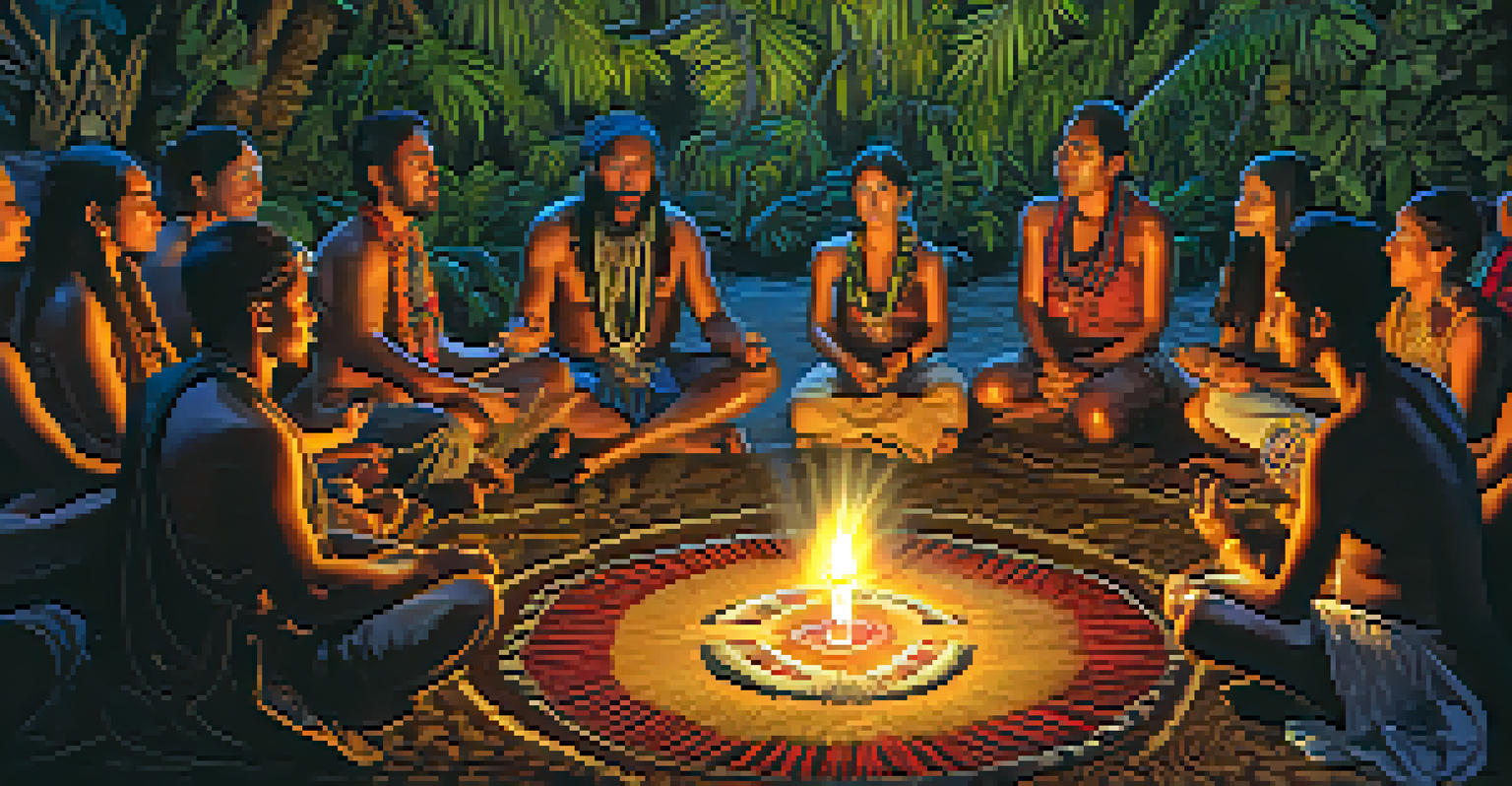The Role of Shaman in Ayahuasca Healing Ceremonies

What is Ayahuasca and Its Healing Properties?
Ayahuasca is a powerful brew made from the Banisteriopsis caapi vine and other plants, traditionally used by indigenous tribes in the Amazon for spiritual healing. This sacred drink contains DMT, a potent hallucinogen that can lead to profound psychological and emotional experiences. Many participants in ayahuasca ceremonies report significant personal insights, emotional healing, and a deeper connection to nature and themselves.
The medicine is not the only thing that heals; it is the context in which it is taken that plays a fundamental role in the healing process.
The healing properties of ayahuasca are often attributed to its ability to facilitate introspection and emotional release. During the ceremony, participants may confront past traumas, fears, and blockages, ultimately leading to healing and transformation. This process is not just about the drug; the setting, intentions, and guidance play crucial roles in the effectiveness of the experience.
In this context, shamans become essential figures, as they provide the knowledge and support needed to navigate the often intense journey of self-discovery that ayahuasca can initiate. They are the bridge between the spiritual and physical realms, helping participants find meaning in their experiences.
The Shaman's Role: More Than Just a Guide
Shamans serve as spiritual leaders and facilitators in ayahuasca ceremonies, combining traditional wisdom with deep cultural knowledge. Their role extends beyond merely administering the brew; they create a safe and sacred space where healing can occur. This involves preparing the environment, setting intentions, and ensuring the well-being of participants throughout the experience.

During the ceremony, shamans utilize various techniques, such as singing icaros (traditional songs) and using sacred instruments, to help guide participants through their journeys. These songs are believed to carry healing energy, assisting in navigating emotional and spiritual landscapes. The shaman’s presence can provide comfort and reassurance, allowing participants to feel more secure in their vulnerable state.
Ayahuasca's Healing Journey
Ayahuasca facilitates deep introspection and emotional healing through guided ceremonies led by experienced shamans.
Moreover, shamans often have extensive training and experience, which enables them to recognize different emotional and physical responses during the ceremony. This awareness allows them to adjust their approach, ensuring that each individual's healing process is respected and supported.
The Importance of Intention in the Ceremony
Intention plays a vital role in the ayahuasca experience, and shamans emphasize its importance prior to the ceremony. Participants are often encouraged to reflect on their motivations for seeking healing, whether it be emotional pain, spiritual growth, or personal insights. This clarity of purpose can significantly influence the outcomes of the ceremony.
Intention is the starting point of every dream. It is the creative power that fulfills our purpose.
Shamans help participants articulate their intentions, framing them in a positive light to foster a constructive experience. By doing so, they create a foundational energy that can guide the journey through the often unpredictable nature of the ayahuasca experience. A clear intention can act as a compass, helping individuals navigate challenges and revelations that arise.
Throughout the ceremony, the shaman continually reinforces the importance of these intentions, supporting participants as they confront their inner landscapes. This ongoing support helps participants stay grounded and focused, ultimately enhancing the healing process.
Creating a Safe and Sacred Space
A key responsibility of the shaman is to create a safe and sacred environment for the ceremony. This includes selecting an appropriate location, preparing the space with spiritual elements, and ensuring that participants feel comfortable and secure. The ambiance plays a significant role in the overall experience, influencing how participants connect with the medicine and themselves.
The shaman often incorporates rituals and traditions that honor the spiritual significance of the ceremony. These practices may include smudging with sacred herbs, invoking spirits, or setting up altars. Such rituals help establish a protective energy, ensuring that the experience remains positive and transformative.
The Shaman's Essential Role
Shamans create a safe environment and use traditional techniques to support participants in navigating their emotional landscapes.
Moreover, the shaman’s presence is crucial for maintaining a calm atmosphere. Their ability to manage the energy in the room and respond to participants’ needs fosters a sense of safety, allowing individuals to fully immerse themselves in their healing journey.
Navigating Challenges During the Ceremony
The ayahuasca experience can sometimes lead to challenging emotions or physical reactions, and this is where the shaman’s expertise becomes invaluable. They are trained to recognize signs of distress and can intervene appropriately to help participants process these feelings. This might involve offering reassurance, adjusting the energy of the space, or guiding them through breathing techniques.
Shamans often share stories or wisdom from their own experiences to help participants feel less isolated in their struggles. By normalizing the challenges of the journey, they empower individuals to confront their emotions head-on. This supportive presence can transform a potentially overwhelming experience into a profound opportunity for growth.
In many ways, the shaman acts as a healer not only through their knowledge of the medicine but also through their empathetic understanding of the human experience. Their unique ability to connect with participants on a spiritual level fosters resilience and courage during the ceremony.
Integration: The Shaman's Continued Support
The journey doesn’t end when the ayahuasca ceremony concludes; integration is a crucial phase where the insights gained are woven into daily life. Shamans often provide guidance on how to process and apply these revelations, helping participants make sense of their experiences. This ongoing support can be instrumental in ensuring lasting change and healing.
Some shamans offer follow-up sessions or community gatherings to facilitate discussion and reflection on the experiences shared during the ceremony. These gatherings create a supportive community where participants can openly share their insights and challenges, reinforcing the lessons learned. This integration process encourages accountability and fosters connections among participants.
Importance of Intention
Setting clear intentions before the ceremony can significantly influence the healing outcomes and overall experience.
Moreover, shamans may introduce practices such as meditation, journaling, or other healing modalities to assist in the integration process. By offering tools and resources, they empower individuals to continue their healing journey beyond the ceremony, promoting long-term well-being.
Cultural Respect and Ethical Considerations
As ayahuasca ceremonies gain popularity outside of indigenous communities, it is essential to approach these experiences with cultural respect and ethical considerations. Shamans often emphasize the importance of understanding the cultural context of ayahuasca and its traditional uses. This respect fosters a deeper appreciation for the wisdom inherent in these healing practices.
Participants are encouraged to educate themselves about the history and significance of ayahuasca within indigenous cultures. This knowledge helps cultivate humility and gratitude, allowing individuals to approach the experience with the appropriate mindset. Acknowledging the origins of ayahuasca also encourages ethical practices and responsible use of the medicine.

By honoring the traditions and teachings of the shamans, participants can contribute to the preservation of these ancient practices. This respect not only enhances the personal experience but also promotes a more sustainable and ethical approach to ayahuasca ceremonies in the modern world.